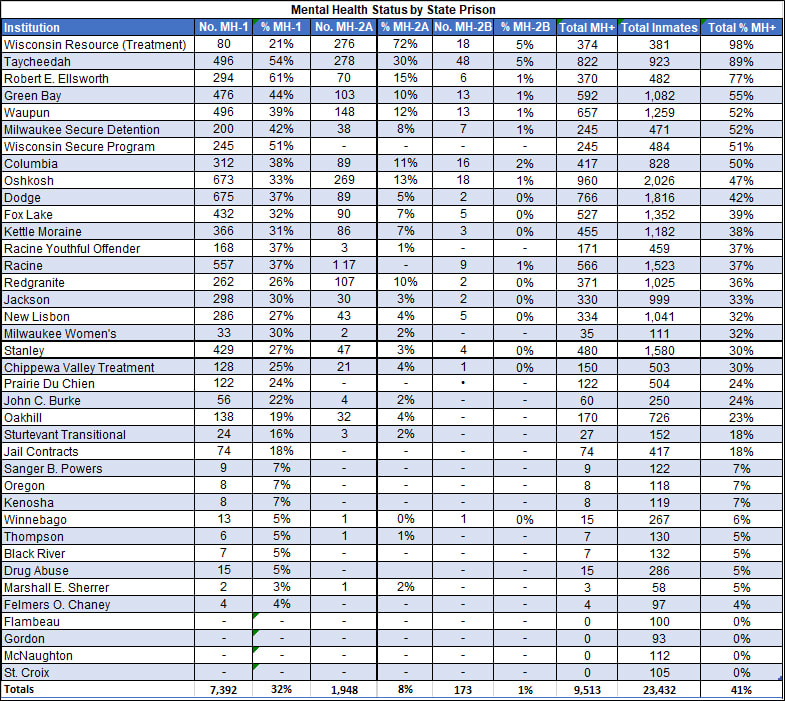41% of State Inmates Have Mental Health Issues
Critics decry use of prisons as dumping grounds for people with mental health problems.
Almost 90 percent of Taycheedah Correctional Institution inmates have mental mental health needs, and more than 300 — 35 percent of the population — have serious mental health illnesses, according to state budget documents.
Overall, according to the Department of Corrections’ 2019-21 budget request, 41 percent of state inmates have mental health issues. The percentages range from 98 percent at the Wisconsin Resource Center, which is designed to serve inmates with special mental health issues, to zero percent at four smaller facilities.
Among prisons housing men, the Green Bay Correctional Institution has the highest rate – 55 percent – of inmates with mental health needs.
Critics decry the use of prisons as dumping grounds for people with mental health problems. The population of mentally ill inmates grew as communities closed down inpatient mental health facilities.
A 2016 report by the Treatment Advocacy Center said that mentally ill inmates remain in jail longer than other inmates, cost more to house than other inmates, cause problems that too often result in stays in solitary confinement, and are more likely than other inmates to commit suicide.
In contrast, just five percent of the general population met that threshold, according to the report, Indicators of Mental Health Problems Reported by Prisoners and Jail Inmates, 2011-12.
The incidence of mental illness is higher among female inmates than male inmates nationwide, the bureau said.
DOC officials recognized the significant needs of Taycheedah inmates in the prison’s 2018 annual report.
Among the serious mental illnesses affecting inmates are “major depressive disorder, bipolar disorder, psychotic disorders, and behavioral disorders, which significantly impact the inmate’s ability to function effectively,” the report said.
“Less significant” mental health issues include “anxiety disorders, adjustment disorders, and less disturbing mood disorders,” the report said. “Approximately 74 percent of the inmates at TCI are prescribed psychotropic medications.”
The prison has a 66-bed special unit for women with significant mental health needs and has psychiatric and psychology services.
The table below shows the levels of mental health needs and the numbers of inmates in each category for each state correctional facility. The table is based on a May 31 snapshot of innate populations.
The definition for each category is below the table. The definitions are taken largely from the DOC budget request.
MH-1 – The inmate is receiving mental health services but does not suffer from a serious mental illness. This code is not appropriate for inmates who are receiving only program services, such as substance abuse or sex offender treatment, and have no other mental health needs.
MH-2A – Inmates with serious mental illness:
A. Inmates with a current diagnosis of, or are in remission from, the following conditions:
- Schizophrenia (all sub types)
- Delusional disorder
- Schizophreniform disorder (a mental disorder where symptoms of schizophrenia are present for a significant portion of the time within a one-month period, but not for the six months required for a schizophrenia diagnosis)
- Schizoaffective disorder (a chronic mental health condition characterized by symptoms of both schizophrenia, and a mood disorder)
- Psychosis not otherwise specified
- Major depressive disorders
- Bipolar disorder 1 and 2 (In bipolar 1, mania swings are more severe than with bipolar 2)
B. Inmates with current or recent symptoms of the following conditions:
- Brief psychotic disorder
- Substance induced psychotic disorder
C. Inmates with head injury or other neurologic impairments that result in behavioral or emotional dyscontrol.
D. Inmates with chronic and persistent mood or anxiety disorders or other conditions that lead to significant functional disability.
MH-2B – Inmates with a primary personality disorder that is severe, accompanied by significant functional impairment, and subject to periodic decompensation; i.e., psychosis, depression, or suicidality. Those who qualify for both MH-2A and MH-2B are coded MH-2A.
Gretchen Schuldt writes a blog for Wisconsin Justice Initiative, whose mission is “To improve the quality of justice in Wisconsin by educating the public about legal issues and encouraging civic engagement in and debate about the judicial system and its operation.
Court Watch
-
No Unemployment Benefits For Worker Making Homophobic Remarks
 May 17th, 2022 by Gretchen Schuldt
May 17th, 2022 by Gretchen Schuldt
-
Appeals Court Upholds Injunction Against Abortion Protester
 Mar 13th, 2022 by Gretchen Schuldt
Mar 13th, 2022 by Gretchen Schuldt
-
80% of State’s Judicial Races Uncontested
 Feb 20th, 2022 by Gretchen Schuldt
Feb 20th, 2022 by Gretchen Schuldt























